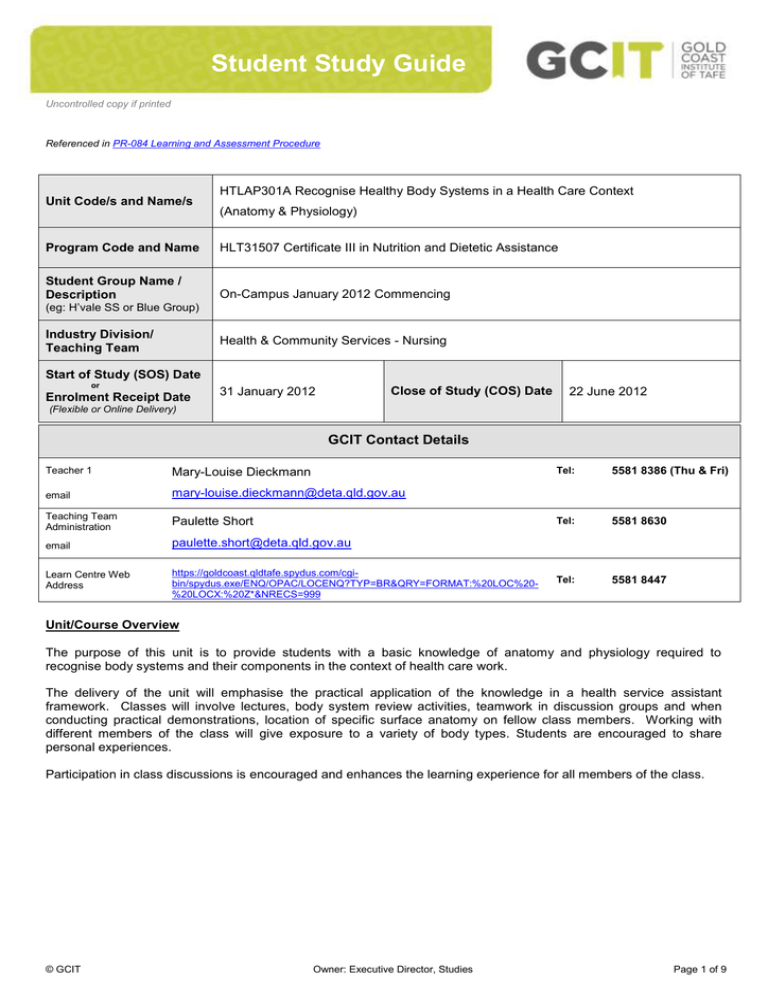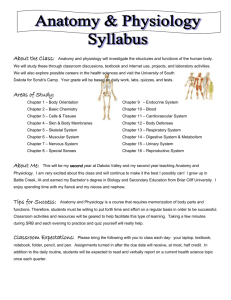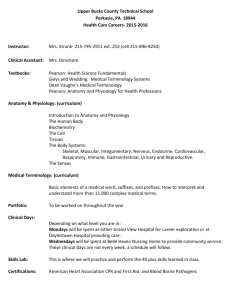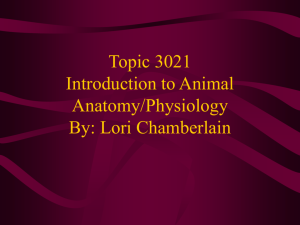
Student Study Guide
Uncontrolled copy if printed
Referenced in PR-084 Learning and Assessment Procedure
Unit Code/s and Name/s
HTLAP301A Recognise Healthy Body Systems in a Health Care Context
(Anatomy & Physiology)
Program Code and Name
HLT31507 Certificate III in Nutrition and Dietetic Assistance
Student Group Name /
Description
On-Campus January 2012 Commencing
(eg: H’vale SS or Blue Group)
Industry Division/
Teaching Team
Health & Community Services - Nursing
Start of Study (SOS) Date
or
Enrolment Receipt Date
Close of Study (COS) Date
31 January 2012
22 June 2012
(Flexible or Online Delivery)
GCIT Contact Details
Teacher 1
Mary-Louise Dieckmann
email
mary-louise.dieckmann@deta.qld.gov.au
Teaching Team
Administration
Paulette Short
email
paulette.short@deta.qld.gov.au
Learn Centre Web
Address
https://goldcoast.qldtafe.spydus.com/cgibin/spydus.exe/ENQ/OPAC/LOCENQ?TYP=BR&QRY=FORMAT:%20LOC%20%20LOCX:%20Z*&NRECS=999
Tel:
5581 8386 (Thu & Fri)
Tel:
5581 8630
Tel:
5581 8447
Unit/Course Overview
The purpose of this unit is to provide students with a basic knowledge of anatomy and physiology required to
recognise body systems and their components in the context of health care work.
The delivery of the unit will emphasise the practical application of the knowledge in a health service assistant
framework. Classes will involve lectures, body system review activities, teamwork in discussion groups and when
conducting practical demonstrations, location of specific surface anatomy on fellow class members. Working with
different members of the class will give exposure to a variety of body types. Students are encouraged to share
personal experiences.
Participation in class discussions is encouraged and enhances the learning experience for all members of the class.
© GCIT
Owner: Executive Director, Studies
Page 1 of 9
Uncontrolled Copy If Printed
For students to achieve a result of ‘competent’ they will need to demonstrate the following:
Essential Knowledge:
Basic structure and functions of the body systems and associated components, including:
- cardiovascular system
- respiratory system
- musculo-skeletal system
- endocrine system
- nervous system
- digestive system
- urinary system
- reproductive system
- integumentary system
- lymphatic system
- the special senses – smell, taste, vision, equilibrium and hearing
- cells, tissues and organs
Basic maintenance for a healthy body
Essential skills:
Ability to:
Accurately use and articulate common health terminology related to human anatomy and physiology.
Apply essential knowledge as outlined to own work role.
Assessment
Each assessment item is briefly described on the following page. The due dates of the assessments are
provided. Students who require an extension for any assessment item need to discuss this with their
teacher and have the request for extension approved using form FM-063. These forms can be obtained
from the Teaching Team Administration office.
NB: To be deemed competent in these courses you will have to successfully complete all of these
assessment tasks. Marking Criteria for these assessments are included in this Study Guide.
The GCIT Form FM-050 Student Assessment Cover Sheet must be attached to all hard copy or email
submitted assessments. This form is available from your teacher, Teaching Team Administration or online
at http://www.goldcoast.tafe.qld.gov.au/resources/pdf/fm_050_assessment_cover_sheet_feedback.pdf.
© GCIT
Owner: Executive Director, Studies
Page 2 of 9
Uncontrolled Copy If Printed
Assessment
No.
AS1
Assessment Description
(These assessments tasks must meet the requirements of the Unit of Competency)
Written Quizzes
Due Date /
Session No.
Quiz 1
You will complete four (4) individual quizzes, comprised of multiple choice
questions, short and long answer questions and/or diagrams of the human
body.
Revision Sheets and Practice exams will be provided to help you to
prepare for these assessments
02 March 2012
Quiz 2
31 March 2012
Quiz 3
11 May 2012
Quiz 4
15 June 2012
AS2
Case Study – 1000 Words
This assessment will be comprised of a written Case Study on a variety of
conditions relevant to the field of nutrition and dietetics.
1st Draft due
27 April 2012
The topics and instructions for this assessment will be distributed in class
in Week 5.
Final
Submission
due 25 May
2012
All assessments must be completed by the date indicated in the table above and resubmissions by the date
negotiated with your teacher.
Refer also to Student Rules http://www.goldcoast.tafe.qld.gov.au/resources/pdf/student_rules07.pdf for
additional information relating to plagiarism, academic appeals, code of conduct, misconduct appeals and
appropriate use of computing and electronic resources.
Exception: Online submission of assessments are exempt from using a GCIT Assessment Cover Sheet as
the learning management system acknowledges receipt of your submission.
© GCIT
Owner: Executive Director, Studies
Page 3 of 9
Uncontrolled Copy If Printed
Delivery Session Schedule
The table below shows you what is planned to be delivered in each session and any variances during delivery.
Please note that your teacher may need to change information in the planned content. Students will be informed
of any changes.
Date
FRI 03
FEB
2012
Time
1300 – 1340
(Lecture)
Unit/s
Delivered
(Code)
HLTAP301A
1350-1500
(Workshop)
FRI 10
FEB
2012
1300 – 1340
(Lecture)
Planned Content
Activities
Week 1
Introduction to Anatomy & Physiology
Introduction to unit - assessment
items, referencing, required readings.
Required Reading:
Essentials of Human
Anatomy & Physiology –
Chapter 1 – pages 1 – 22.
Introduction to the Human Body
What is Anatomy & Physiology?
Levels of Structural Organisation
Organ System Overview
Maintaining Life & Homeostasis
Worksheet 01 –
Introduction to the Human
Body
Week 2
HLTAP301A
Cells
The Anatomy of a Generalised Cell
1350-1500
Cell Diversity
(Workshop)
Cell Physiology
Required Reading:
To be advised
Worksheet 02 – Cells &
Body Tissues
Cell Division
FRI 17
FEB
2012
1300 – 1340
(Lecture)
HLTAP301A
Week
(Note:3you do NOT need to cover
the
on protein
synthesis)
Thesection
Integumentary
System
Classification of Body Membranes
1350-1500
Epithelial Membranes
(Workshop)
Connective Tissue Membranes
Required Reading:
To be advised
Worksheet 03 – The
Integumentary System
The Integumentary System
FRI 24
FEB
2012
1300 – 1340
(Lecture)
1350-1500
Basic Skin Functions
Structure of the Skin
Homeostatic Imbalances of the
Skin
Week 4
HLTAP301A
The Skeletal System
Required Reading:
To be advised
Bones: Classifications & Types Identify the major bones of the body
Worksheet 04 – The
Skeletal System
(Workshop)
Bone growth and repair
Joints and Ligaments, Movement of
Joints
Spinal disfigurements & fractures
© GCIT
Owner: Executive Director, Studies
Page 4 of 9
Uncontrolled Copy If Printed
Date
FRI 02
MAR
2012
Time
1300 - 1500
Unit/s
Delivered
(Code)
HLTAP301A
FRI 02
MAR
2012
FRI 09
MAR
2012
Planned Content
Activities
Week 5
Assessment 1 Part 1 (Quiz 1) to be completed during this session
Distribution of Case Study topics
1300 – 1340
(Lecture)
HLTAP301A
Week 6
The Muscular System
Three types of muscle tissue
1350-1500
Skeletal muscle of the body
Required Reading:
To be advised
Worksheet 05 – The
Muscular System
(Workshop)
FRI 16
MAR
2012
1300 – 1340
(Lecture)
HLTAP301A
Week 7
The Cardiovascular System
Required Reading:
To be advised
Components of blood
1350-1500
Physical Characteristics
(Workshop)
Plasma
Formed elements
Worksheet 06 – The
Cardiovascular System
Hematopoiesis
Blood Groups and Transfusions
The Heart
Anatomy of the Heart
Location
Coverings and wall
Chambers and valves
Physiology of the Heart
Setting the rhythm
Blood Vessels
Microscopic Anatomy
Structural differences
Gross anatomy of Vessels
© GCIT
Owner: Executive Director, Studies
Page 5 of 9
Uncontrolled Copy If Printed
Date
FRI 23
MAR
2012
Time
1300 – 1340
(Lecture)
Unit/s
Delivered
(Code)
HLTAP301A
Planned Content
Week 8
The Nervous System
Activities
Required Reading:
To be advised
Organization of the Nervous System
Nervous Tissue: Structure and
Function
1350-1500
(Workshop)
Worksheet 07 - The
Nervous System
The Central Nervous System
Functional Anatomy
Protection of the CNS
The Spinal Cord
Peripheral Nervous System
Spinal and Cranial Nerves
FRI 31
MAR
2012
1300 - 1500
HLTAP301A
02 – 16 APRIL 2012
FRI 20
APR
2012
1300 – 1340
(Lecture)
Week 9
Assessment 1 Part 2 (Quiz 2) to be completed during this session
MID SEMESTER BREAK
HLTAP301A
Week 10
The Endocrine System
Required Reading:
To be advised
Overview
1350-1500
Mechanisms of Hormone Action
(Workshop)
Control of Hormone Release
Worksheet 08 - The
Endocrine System
Major Endocrine Organs
Pituitary Gland, Thyroid Gland,
Parathyroid Glands
Adrenal Glands
Pancreatic Islets
Pineal Gland, Thymus Gland
Gonads
Other Hormone-Producing Tissues
and Organs
FRI 27
APR
2012
1300 – 1340
(Lecture)
1350-1500
(Workshop)
FRI 27
APR
2012
© GCIT
HLTAP301A
Week 11
The Lymphatic System
Lymphatic vessels
Lymph nodes
Other lymphoid organs
Required Reading:
To be advised
Worksheet 09 – The
Lymphatic System
1st Draft of Case Study due – 1700 today
Owner: Executive Director, Studies
Page 6 of 9
Uncontrolled Copy If Printed
Date
FRI 04
MAY
2012
Time
1300 – 1340
(Lecture)
Unit/s
Delivered
(Code)
HLTAP301A
1350-1500
(Workshop)
FRI 11
MAY
2012
1300 - 1500
FRI 18
MAY
2012
1300 – 1340
(Lecture)
HLTAP301A
HLTAP301A
Planned Content
Week 12
The Respiratory System
Functional anatomy
Required Reading:
To be advised
Respiratory Physiology
Pulmonary ventilation
External respiration
Gas transport
Internal respirations
Worksheet 10 – The
Respiratory System
Week 13
Assessment 1 Part 3 (Quiz 3) to be completed during this session
Week 14
The Digestive System
Anatomy of the Digestive System
1350-1500
(Workshop)
Activities
Accessory digestive organs
Salivary glands
Teeth
Required Reading:
To be advised
Worksheet 11 – The
Digestive System
Gastrointestinal Processes
Ingestion, Propulsion, Chemical &
mechanical digestion, Absorption
& Defecation
FRI 25
MAY
2012
1300 – 1340
(Lecture)
HLTAP301A
Week 15
The Urinary system
Required Reading:
To be advised
Anatomy of the Urinary System
1350-1500
(Workshop)
Micturition
Worksheet 12 – The
Urinary System
Fluid, Electrolyte & Acid-base Balance
FRI 25
MAY
2012
FRI 01
JUN
2012
Final Submission of Case Study due 1700 today
1300 – 1340
(Lecture)
HLTAP301A
Week 16
The Special Senses
1350-1500
Required Reading:
To be advised
The Eye and Vision
(Workshop)
The Ear: Hearing & Balance
Worksheet 13 – The
Special Senses
Taste and Smell
© GCIT
Owner: Executive Director, Studies
Page 7 of 9
Uncontrolled Copy If Printed
Date
FRI 08
JUN
2012
Time
1300 – 1340
(Lecture)
Unit/s
Delivered
(Code)
HLTAP301A
Planned Content
Week 17
The Reproductive System
The Male Reproductive System
Anatomy:
testes, duct system, urethra
accessory glands & semen, external
genitalia
1350-1500
(Workshop)
Activities
Required Reading:
To be advised
Worksheet 14 – The
Reproductive System
Male Reproductive Functions –
Spermatogenesis and testosterone
production
The Female Reproductive System
Anatomy:
ovaries, duct system, uterus, vagina
and external genitalia
Female Reproductive Functions:
Oogenesis, the ovarian cycle, hormone
production by the ovaries and
mammary glands
FRI 15
JUN
2012
1300 - 1500
FRI 22
JUN
2012
1300 – 1500
HLTAP301A
Week 18
Assessment 1 Part 4 (Quiz 4) to be completed during this session
HLTAP301A
Week 19
Review Week and Resits (if required)
NB: This is a proposed schedule, however, due to the dynamic nature of the environment and
possible changes that may occur, classes may not follow the above format.
.
© GCIT
Owner: Executive Director, Studies
Page 8 of 9
Uncontrolled Copy If Printed
Assessment Marking Criteria
Assessment 1 Quiz 1
Knowledge of common health terminology relating to human anatomy and physiology
Knowledge of basic structure and functions of the concepts underpinning human anatomy and physiology, including:
- Understanding of the structure and function of cells.
- Knowledge of the structure and physiology of the Integumentary system
Knowledge of basic maintenance for a healthy body
Assessment 1 Quiz 2
Knowledge of common health terminology relating to human anatomy and physiology
Knowledge of basic structure and functions of the concepts underpinning human anatomy and physiology, including:
- skeletal system
- muscular system
- cardiovascular system
Knowledge of basic maintenance for a healthy body
Assessment 1 Quiz 3
Knowledge of common health terminology relating to human anatomy and physiology
Knowledge of basic structure and functions of the concepts underpinning human anatomy and physiology, including:
- Nervous system
- Endocrine system
- Lymphatic system
Knowledge of basic maintenance for a healthy body
Assessment 1 Quiz 4
Knowledge of common health terminology relating to human anatomy and physiology
Knowledge of basic structure and functions of the concepts underpinning human anatomy and physiology, including:
- Respiratory system
- Digestive system
- Urinary System
- Special Senses
- Reproductive System
Knowledge of basic maintenance for a healthy body
Marking Criteria – Case Study
Knowledge of common health terminology relating to human anatomy and physiology
Knowledge of basic structure and functions of the Digestive system and basic maintenance for a healthy body.
Textbooks – recommended (not required):
Marieb, E.N. (2012). Essentials of Human Anatomy & Physiology (10h ed.). San Francisco, USA: Pearson Prentice
Hall.
Websites:
To be advised by teacher
Study Guide Developed By:
Teacher Name
Teacher Signature
Mary-Louise Dieckmann
Teacher Name
© GCIT
Page 9 of 9
Date
24 January 2012
Teacher Signature
Owner: Executive Director, Studies
Do not save copy of blank form for reuse
Date
GD-031 V7







